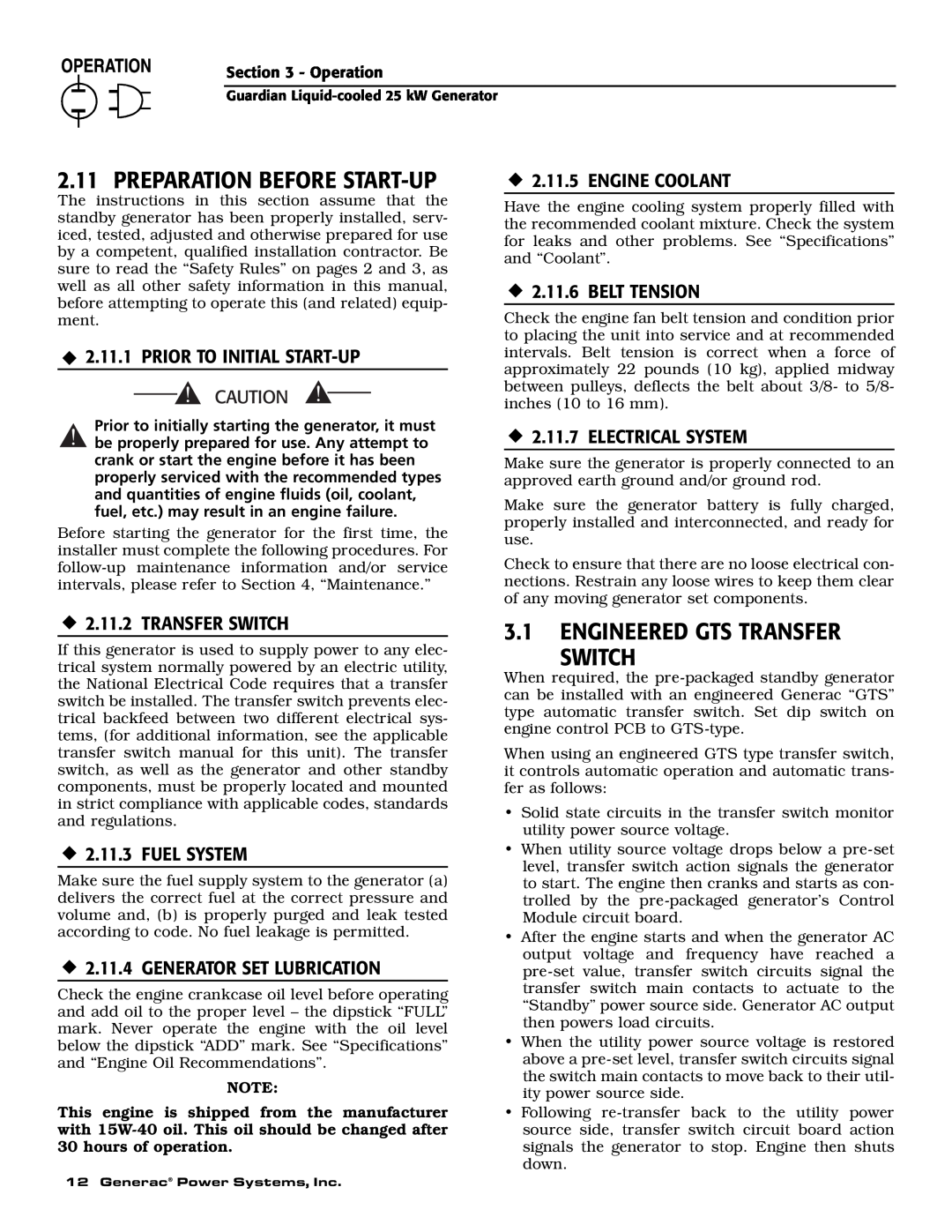
Section 3 - Operation
Guardian
2.11 PREPARATION BEFORE START-UP
The instructions in this section assume that the standby generator has been properly installed, serv- iced, tested, adjusted and otherwise prepared for use by a competent, qualified installation contractor. Be sure to read the “Safety Rules” on pages 2 and 3, as well as all other safety information in this manual, before attempting to operate this (and related) equip- ment.
2.11.1 PRIOR TO INITIAL START-UP
Prior to initially starting the generator, it must
!be properly prepared for use. Any attempt to crank or start the engine before it has been properly serviced with the recommended types and quantities of engine fluids (oil, coolant, fuel, etc.) may result in an engine failure.
Before starting the generator for the first time, the installer must complete the following procedures. For
2.11.5 ENGINE COOLANT
Have the engine cooling system properly filled with the recommended coolant mixture. Check the system for leaks and other problems. See “Specifications” and “Coolant”.
2.11.6 BELT TENSION
Check the engine fan belt tension and condition prior to placing the unit into service and at recommended intervals. Belt tension is correct when a force of approximately 22 pounds (10 kg), applied midway between pulleys, deflects the belt about 3/8- to 5/8- inches (10 to 16 mm).
2.11.7 ELECTRICAL SYSTEM
Make sure the generator is properly connected to an approved earth ground and/or ground rod.
Make sure the generator battery is fully charged, properly installed and interconnected, and ready for use.
Check to ensure that there are no loose electrical con- nections. Restrain any loose wires to keep them clear of any moving generator set components.
2.11.2 TRANSFER SWITCH
If this generator is used to supply power to any elec- trical system normally powered by an electric utility, the National Electrical Code requires that a transfer switch be installed. The transfer switch prevents elec- trical backfeed between two different electrical sys- tems, (for additional information, see the applicable transfer switch manual for this unit). The transfer switch, as well as the generator and other standby components, must be properly located and mounted in strict compliance with applicable codes, standards and regulations.
2.11.3 FUEL SYSTEM
Make sure the fuel supply system to the generator (a) delivers the correct fuel at the correct pressure and volume and, (b) is properly purged and leak tested according to code. No fuel leakage is permitted.
2.11.4 GENERATOR SET LUBRICATION
Check the engine crankcase oil level before operating and add oil to the proper level – the dipstick “FULL” mark. Never operate the engine with the oil level below the dipstick “ADD” mark. See “Specifications” and “Engine Oil Recommendations”.
NOTE:
This engine is shipped from the manufacturer with
12 Generac® Power Systems, Inc.
3.1ENGINEERED GTS TRANSFER
SWITCH
When required, the
When using an engineered GTS type transfer switch, it controls automatic operation and automatic trans- fer as follows:
•Solid state circuits in the transfer switch monitor utility power source voltage.
•When utility source voltage drops below a
•After the engine starts and when the generator AC output voltage and frequency have reached a
•When the utility power source voltage is restored above a
•Following
